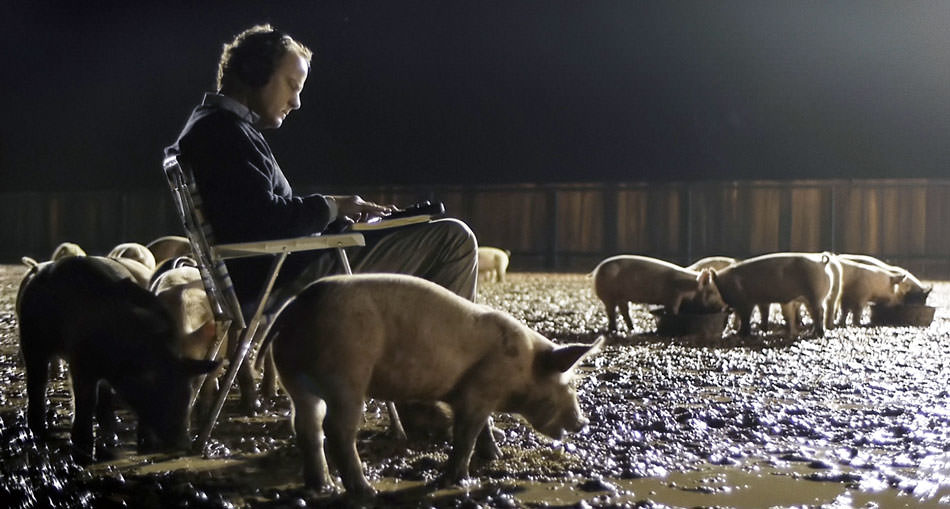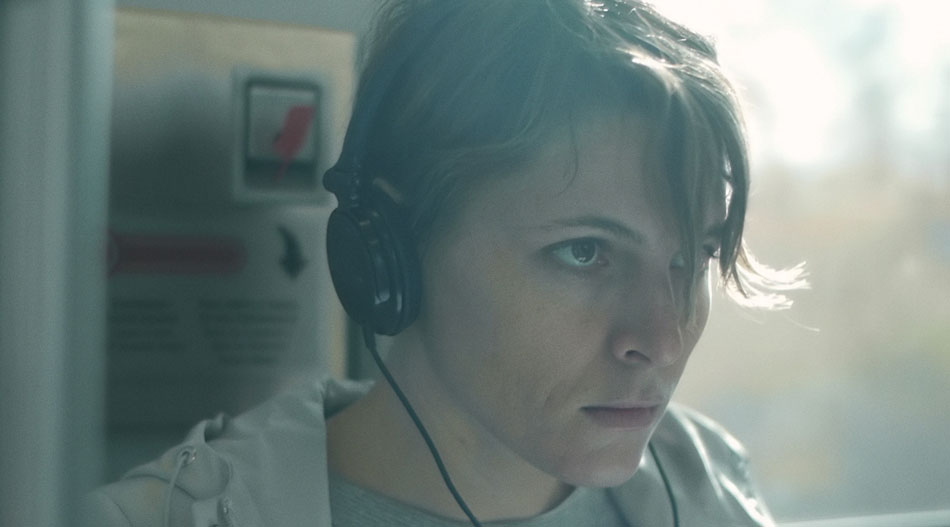Upstream Color, Shane Carruth’s long-awaited second film, begins with an extended sequence of victimization, extraordinary in its deadpan brutality. A young woman (Kris, one of only two characters given real names, played by Amy Seimetz) is stun-gunned outside a bar by a deceptively pleasant-looking man, referred to in the credits as the Thief. He forces a strange grub-like creature down her throat, and she wakes up as a sort of zombie—blank, passive, absolutely credulous and obedient. Over the course of several days, the Thief issues her a series of slightly surreal instructions—she is to neither eat nor sleep, treat a glass of ice water as her greatest desire, spend her time copying Thoreau’s Walden out page by page—takes all her valuables, empties her bank account, even makes her take out a loan on her home to give him more money. Meanwhile, the creature grows inside her, and squirms visibly under her skin.
All this is presented with an incongruous calmness and warmth: soft lighting, lingering, tactile close-ups, and a gently soothing synthesizer score. Carruth’s editing is sudden and fragmentary—he tends to cut away as soon as he’s made his point, often before it’s quite had time to register with the viewer—but in a way that is more hypnotic than jarring. This is a style that continues throughout the film: even the most insane or disturbing moments are presented as nothing of the sort, as if the repulsion one feels at seeing, for instance, Kris attempt to cut the creature out of her leg with a kitchen knife after the Thief finally leaves her, is simply a mistake, an ignorant misunderstanding. The result is a slow, thorough unmooring of the viewer’s responses. While we have some idea of what is going on in the film, we have no idea how we’re supposed to feel about it.
Carruth gained a cult following with his first film, the similarly odd, intricate Primer (2004), about a pair of engineers who accidentally invent a form of limited time travel in their garage. Made on an absurdly small budget (Carruth directed, shot, edited, scored, produced, and starred in both his films), its plot culminated a flurry of reversals, revelations, and treacherous doppelgangers—at times as fragmented and baffling as his new film. But Primer was ultimately much more conventional, a puzzle film with a solution to be worked out in elaborate online flow-charts and exegeses. Upstream Color is something else: a genuine, lasting mystery.
The strangeness comes in part from the very odd movements of the film’s plot, which swerves off each time it seems to be coming to a recognizable climax. Unceremoniously abandoned by the Thief (who is almost totally absent from the rest of the film), Kris eventually finds her way to a rather professorial man called the Sampler, who removes the parasitic creature from her body. It now looks rather like a very long tapeworm, but instead of killing it the Sampler transfers it to the belly of a live pig (this scene is one of the few in the film that verges on schlock); we later see that he tends a whole herd of such infected pigs. He sews Kris back up, then he, too, abandons her.
She wakes with no memory of any of these events, but with her life in shambles. She loses her job, her savings, her house, her trust in her own thoughts and actions. Searching for some explanation of what has happened—of what she has done—she decides she’s had a mental breakdown and goes on medication. But the effects of the creature linger: her mind is now somehow linked to the animal that contains her parasite, her emotional life invaded by the pig’s; she dreams of the pig, and she feels, without knowing why, some version of what it feels. Far more than Kris’s physical victimization, it is this terrifying mental vulnerability, this incursion of emotions, memories, and impulses from without, that is at the core of the film.
With sudden shifts of tone, perspective, and rhythm, bursts of talk and long stretches of silence, irregular swings from the mundane to the bizarre or even ridiculous—from flower markets to psychic pig farmers, from first dates to passionate poolside recitations of Walden—Upstream Color works hard to keep its audience as much at sea as its characters. By turns science fiction and horror, romance and mystery, revenge flick and Malickian nature-reverie, it combines so many genres as to render them meaningless. Watching, one begins to feel some small semblance of the disorientation Kris feels, the sense that even the most familiar and intimate things—feeling thirsty, or watching two people talk in a movie—can betray you, suddenly and inexplicably.
Advertisement
Even the most normal scenes become charged with uneasiness. Midway through the movie, Kris meets a man, a disgraced banker named Jeff (played rather flatly by Carruth, as if attempting to keep attention squarely on Kris), and they fall in love. We see them making out in her kitchen, the camera peeking voyeuristically around a corner. They grapple a little awkwardly, part, return to each other—the soundtrack is just the muffled rustlings of their contact—and in a film so filled with convincing craziness this basic human interaction is almost shocking. For a moment what they’re doing seems absolutely alien and ridiculous. And then you remember that, no, this is just how people kiss.
The sequence that shows Carruth’s vision at its purest—the sequence that, though it is far from the end of the film, one might think its whole strange structure was built to support—comes well into Kris and Jeff’s relationship. It is clear early on that Jeff too was once infected with the parasite, though he blames his mysterious breakdown on a drug addiction rather than mental illness. As their romance begins we see their respective pigs pair off as well, a giddily odd fusion of meet-cute and anthropomorphic surrealism; it is unclear which affair is causing which, or if all four are simply moving in harmony. That this conceit isn’t just goofy and nonsensical, that it is in fact sort of irresistible, is a real achievement, a testament to Seimetz’s delicately naturalistic performance and to Carruth’s conviction as a filmmaker (and perhaps to the untapped potential of pigs as romantic leads).
But then their porcine counterparts have piglets, and the Sampler, perturbed by the aggressive protectiveness of the new parents, takes the piglets from them and drowns them in a nearby river. Kris and Jeff, who of course have no idea that any of this has occurred—who as yet don’t even know about the pigs—have a kind of sympathetic breakdown. The fear and rage of the pigs floods their minds: Jeff attacks several of his coworkers, Kris punches out windows; they hunt desperately for each other, embrace, rush home, bewildered, at the mercy of fear and rage they can neither explain nor control. It is a harrowing sequence, in its quieter way the equal of the film’s opening, but its final image is almost hopeful, however perverse the setting: Kris and Jeff lying fully clothed in the tub, clinging to each other, united, waiting for the storm inside them to break.
Carruth was an engineer before turning to filmmaking, and at times he seems to be working with a scientific rather than an artistic method. It is as if he is trying, in a very literal way, to make a movie that is solely about emotions, not emotional events or situations or even people. He uses the elaborate rigamarole of his story to methodically abstract his character’s internal lives, divorce them from causation, from personality, understanding, and control, without reducing their emotional intensity—to turn them, one might say, into an isolated system, uncontaminated, ready for study. The hypothesis (one that has emerged in other forms in recent years) is that our emotional lives are in any case far less “ours” than we think. Feelings, impulses, reactions—they simply arrive, from who knows where, for who knows what reason. We are left to deal with them as best we can, to piece together some workable self from whatever’s close to hand.
Upstream Color is currently playing in theaters, and is available on DVD, Blu-Ray, and as an HD download.



